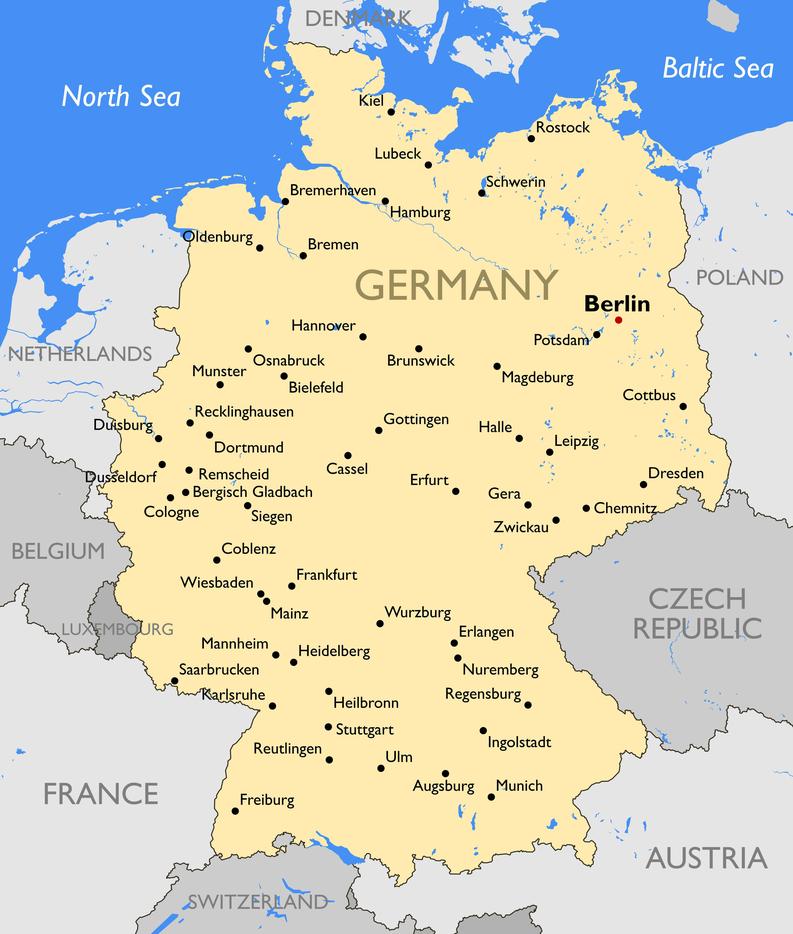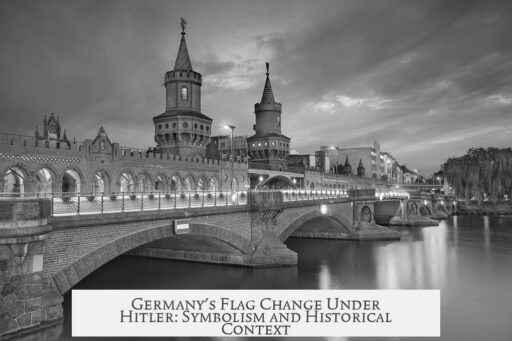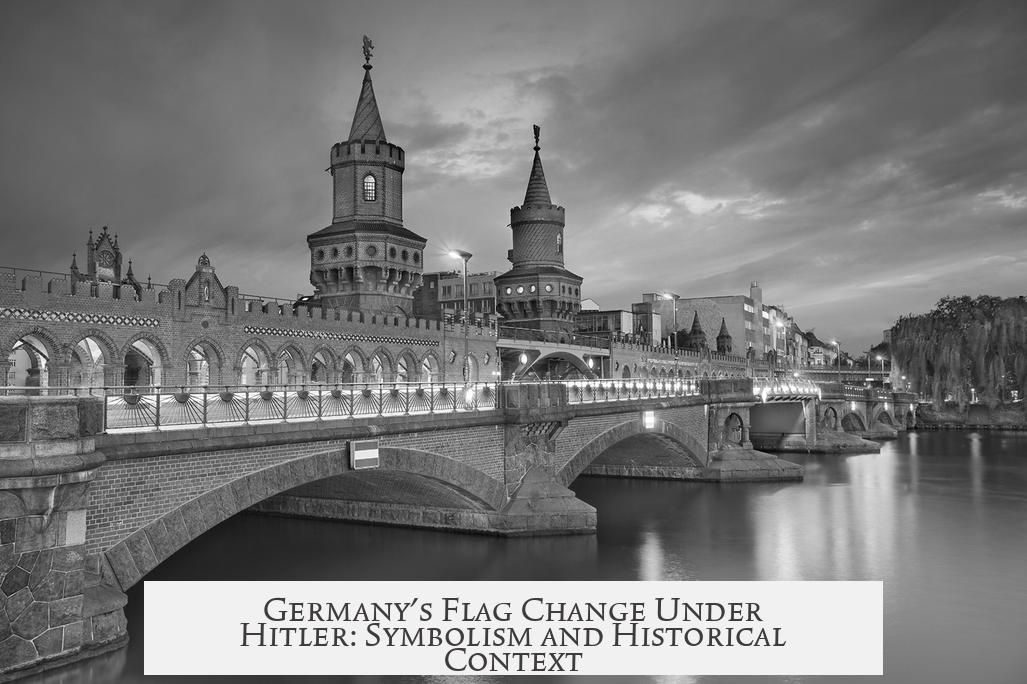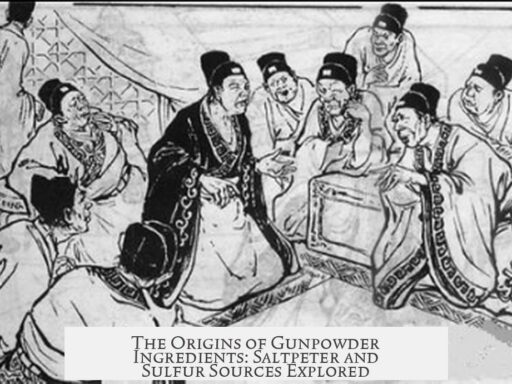Germany changed its flag when Hitler took control to reject the democratic and republican symbolism of the black-red-gold flag, which the Nazis viewed as a betrayal of German nationalism. Instead, the Nazis reinstated imperial colors with a new emblem, aligning the flag with their ideology and political goals.

The black-red-gold flag represented the Weimar Republic and Germany’s democratic traditions dating back to the 1848 Revolution. The Nazis considered this flag a symbol of traitors, linked to the perceived betrayal at the end of World War I and the “stab-in-the-back” myth. The Nazi party sought to erase this legacy by replacing it with a flag rooted in conservative nationalist symbolism.
Before Nazi control, Germany’s flags reflected varying political eras:

- Imperial Flag (1871‒ca. 1918): The black-white-red tricolor represented Imperial Germany. It originated from the North German Confederation to unify German ships under one ensign. This flag symbolized monarchy and the pre-war German Empire.
- Black-Red-Gold Flag: Associated with the democratic revolution of 1848 and later adopted by the Weimar Republic after 1918. This flag symbolized unity, democracy, and a break from imperial and Prussian heritage.
The conservative and far-right factions in Germany strongly opposed the black-red-gold flag. They saw it as a marker of Germany’s defeat and humiliation in World War I and the democratic government that replaced the Kaiser. Many conservatives pushed to restore the imperial black-white-red flag. Extremist paramilitary groups like the Freikorps openly embraced this imperial battle flag, seeing it as a symbol of nationalist resistance.
The Nazi party borrowed the black-white-red colors of the imperial flag but introduced the swastika, a new symbol representing National Socialism. This combination served to unify various right-wing nationalist sentiments by merging historical imperial colors with fresh ideological imagery. It helped the Nazis to appeal to old imperial loyalists and new radical supporters simultaneously.

When Hitler rose to power, the Nazi swastika flag did not immediately become the sole national flag. Instead, Germany used dual flags for some years:
- The imperial black-white-red flag
- The Nazi swastika flag
This dual flag policy caused tensions abroad. For example, in 1935, the German ocean liner Bremen caused outrage in New York City when protesters tore off the swastika flag it flew. The Nazi government faced mounting international pressure because the swastika flag symbolized radical nationalism and was associated with an aggressive regime.

The death of President Paul von Hindenburg in 1934 allowed Hitler to consolidate power further. Shortly afterward, in 1935, the Nazi government formally decreed that the swastika flag would become the sole national flag of Germany. This step eliminated the imperial black-white-red flag and firmly tied the country’s identity to Nazi symbolism and control.
| Period | Flag | Symbolism |
|---|---|---|
| 1871-1918 | Black-White-Red tricolor | Imperial Germany, monarchy, national unity under the Kaiser |
| 1919-1933 | Black-Red-Gold tricolor | Weimar Republic, democracy, 1848 Revolution |
| 1933-1935 | Dual: Imperial and Nazi Swastika flags | Transition period; Nazi swastika emerges alongside imperial colors |
| 1935 onward | Swastika flag only | Official Nazi symbol, totalitarian regime identity |
In brief, the Nazi flag change reflects a political and ideological shift. The black-red-gold flag evoked democracy and republicanism, linked to Germany’s perceived humiliation in World War I. Nazis rejected it as a symbol tied to traitors and embraced imperial colors fused with their swastika to represent their nationalist, authoritarian vision. The flag change was part of a broader campaign to legitimize Nazi rule and recreate German national identity.

- The Nazi flag replaced the Weimar black-red-gold to reject democracy.
- Imperial black-white-red colors linked old nationalism with Nazi ideology.
- Initially, both imperial and swastika flags flew as national symbols (1933-1935).
- Growing tensions and Hindenburg’s death led to exclusive adoption of the swastika flag.
- The flag change symbolized Nazi consolidation of political power and identity.
Why Did Germany Change Its Flag When Hitler Took Control of the Country?
Germany changed its flag when Hitler seized power because the Nazis rejected the democratic symbolism of the existing black-red-gold flag, viewing it as a betrayal of German nationalist tradition. They replaced it with a flag combining imperial colors and the swastika to unite old nationalist imagery with their new ideology.

Let’s unfold this story step-by-step, revealing how the flag’s evolution reflects profound shifts in German identity and ideology during this turbulent period.
After World War I, Germany’s flag was a symbol of its fragile democracy. The black-red-gold tricolor emerged with the Weimar Republic, representing democracy and unity sparked by the 1848 Revolution’s ideals. It harked back to the Paulskirche parliament, a beacon of German emancipation from monarchy and empire.
But not everyone loved this flag. To many conservatives and right-wing groups, including the Nazis, black-red-gold was a mark of betrayal. They blamed the Weimar leaders for Germany’s humiliating defeat in World War I, calling them “November criminals” who stabbed the country in the back. The flag became a symbol of weakness and failure to these factions.
A Glance Back: Flags and History Before Hitler
The German Empire (1871–1918) used a black-white-red tricolor. This flag was the standard under Kaiser Wilhelm, signifying imperial power and the Prussian-led German unification. It wasn’t merely a Prussian banner; rather, it symbolized the new empire’s authority, including its military victories—until they lost World War I, of course.
When the empire collapsed in 1918, the black-red-gold flag returned to flight as a symbol of republicanism. Hitler’s Nazis, however, saw the imperial flag as a more fitting emblem for their nationalist ambitions. They longed to revive the old imperial glory while infusing it with their radical ideology.
Why the Nazis Hated the Black-Red-Gold Flag
The Nazis condemned the black-red-gold flag as the flag of traitors. To them, the democratic Weimar Republic stood for everything anti-German: weakness, betrayal, and surrender. They linked it directly with Germany’s defeat and the disgrace of November 1918, when the Kaiser abdicated and Germany transitioned to democracy.
This opposition wasn’t just rhetorical. Far-right paramilitary groups, notably the Freikorps, openly waved the imperial battle flags, symbolizing their refusal to accept the Republic’s legitimacy. It’s like they said, “Democracy? No thanks, give us back the glory days.”
The Nazi Flag: A Fusion of Old and New
When the Nazi Party (NSDAP) crafted their flag, they cleverly borrowed the black-white-red colors from the imperial flag. But here’s the kicker: they added the swastika, a new symbol meant to represent National Socialism. This design brilliantly connected the conservative nationalists’ love for imperial colors with the Nazis’ revolutionary ideals.
This symbolic mashup gave the Nazis a marketing edge. Instead of risking confusion with competing far-right groups, they packaged a familiar color scheme in a fresh, terrifying way. So the flag truly was a bridge—between old monarchic Germany and an aggressively new regime.
Dual Flags in a Time of Transition
Here’s a surprising fact: When Hitler first rose to power in 1933, the swastika flag was not the sole national flag. Both the old imperial black-white-red and the Nazi swastika flags flew side by side. This somewhat half-hearted approach reflected the regime’s cautious consolidation of power.
However, this dual-flag situation sparked international controversy. In 1935, protests reached a dramatic peak when New Yorkers tore the Bremen ocean liner’s German flag—a slap in the face to the Nazi regime. This incident underscored that symbols matter globally, not just domestically.
The Final Switch: Swastika Becomes the Sole Flag
The official switch came after President Paul von Hindenburg’s death in August 1934. Once Hitler merged the presidency with his own chancellorship, the regime no longer needed to maintain appearances or tolerate old symbols that complicated their vision. In 1935, the Nazi swastika flag became the **only** national flag.
From that point onward, the black-red-gold flag was banished, buried with the democratic ideals it once represented. The swastika flag boomed as the sole banner of Germany, symbolizing the sinister new order.
Why Does This Matter Today?
Flags are more than colored cloth; they are vessels of identity and ideology. The story of Germany’s flag change under Hitler shows how symbols can be weaponized to rewrite national narratives. It teaches us to look beyond aesthetics to understand what a flag represents to those who wield it.
Could similar shifts happen today? What symbols does your country fly, and what do they signify? The German example reminds us that flags tell a deep story about where we come from and where we might be headed—and sometimes, those stories are rewritten in unsettling ways.
So next time you see a flag, question: What history bleeds within these colors? Who does it represent? In Germany’s case, changing the flag was a bold move to erase one tradition and forcibly impose another—leaving a lasting legacy tangled in history’s darkest chapters.



